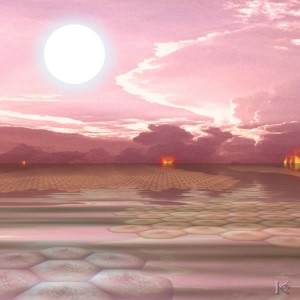Most aliens in science-fiction movies are disappointing. Even the aliens in a program I saw last night speculating on an invasion were unimaginative. They went with the usual humanoid with a skin condition and large eyes deal. Real aliens would surely be very different from anything we can imagine. Here’s one example of just how different they could be, drawn up by my talented artistic friend Karen Wehrsten a few years ago.
Qax were dreamed up by hard sci-fi writer Stephen Baxter, and they are weird! Qax biology is based around chemical hyper-cycles embedded in convection cells. A Qax is millions of such cells arranged on the sea surface in a branching pattern covering several miles. Each cell is as wide as a coffee can lid, languidly bubbling like chocolate with nested eddies down to the microscopic level; they’re highly organized, living storms.
Shown right, on a young, simmering ocean world, under an oversized blue-white star, the tendrils of one Qax reach out to the limb of another in the distance. The bluish sunlight is filtered and scattered to a pinkish orange by a dense blanket of CO2 spiked generously with hydrocarbon and sulfur compounds. Undersea volcanoes light up the horizon and belch more toxic gas into the air.
In Baxter’s Xeelee series, the Qax at one time enslaved mankind. Humans eventually threw them off thanks to the efforts of mostly one guy, but the Qax never forgot us. They spent the next 5 million years learning to live in other turbulent systems, gas giants, stars, even the quantum turbulence of empty space. All the time they had one species goal, revenge.
That last part definitely sounds human. Hopefully, in the next few weeks, I’ll have another alien taken from another writer’s dreams that is even more alien, in some respects, than the Qax!


Peter F. Hamilton has his Commonwealth Saga (first book is Pandora’s Star) which has an unconventional species as well (some kind of amoeba like race). Interesting read.
I love this question. It’s not asked enough, really, because the easy way out for most writers is the damned “space elves” thing. That or giant bugs seems to be the limit of most imaginations. I think that is probably why I appreciate authors like Banks and Bear so much more, the aliens really are alien. Well…and so are the humans, but that’s another question entirely.
It is a great question, fascinating, if only we had better data!
What type aliens are we most likely to interact with? We probably would have comparatively little in common with extreme aliens like Jovian or other extreme worlds. We would probably have the most in common with mobile terrestrial species that breath oxygen. (I’m sure there would be many exceptions but it’s easier to deal with beings that can live on your ship with a minimum of life support.)
What types of locomotion are available on land? Legs, wheels, etc. Legs are simpler than most alternatives. You also needs some kind of hands. Turning one set of legs into hands is one approach. Will there be other solutions? Of course, but bipedalism will be part of the mix. I just hate when every species is bipedal.
I hated the Qax when I read the storys they appear in, actually. They came across as a prime example of coming up with something really weird, and then utterly failing to explore any possible ramifications of the weirdness. They were treated exactly as if they were humanoid oppressors except for the fact that they had difficulty travelling.
At one point somebody actually asks “What do these damn things WANT?” And the bit character on exposition duty answers “immediate profit.” It made me want to scream. That’s like “to get to the other side!” What the hell constitutes profit for a genius loci just went entirely unexplored.